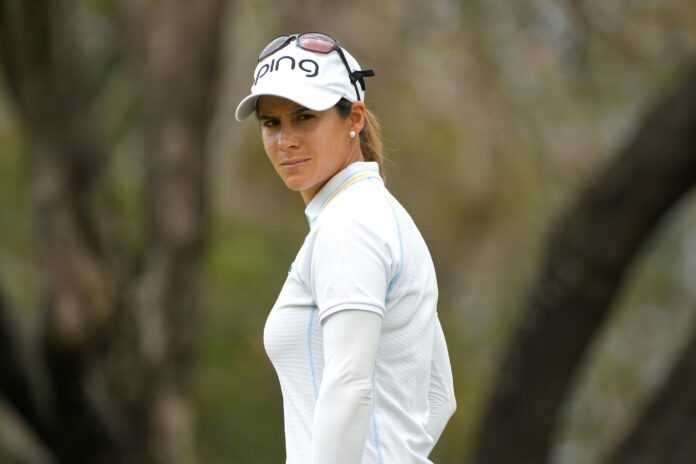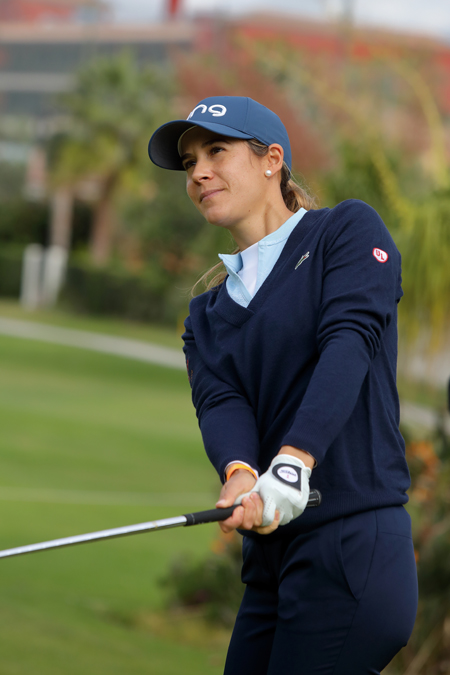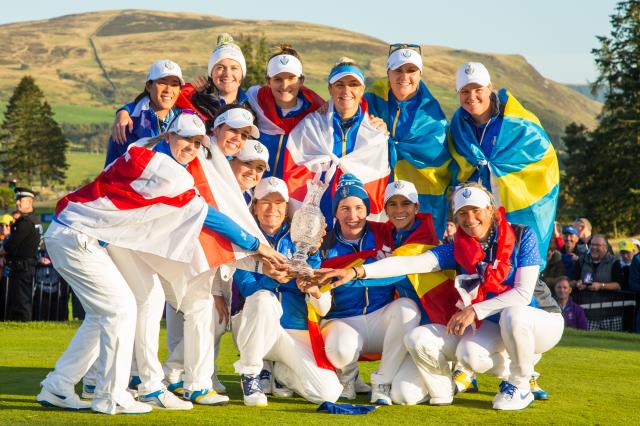Azahara Muñoz took the decision to become a mum in 2021 and continued competing with Lucas in her tummy during the first seven months of her pregnancy.
Becoming a mother is an important decision for any elite sportswoman. Especially in golf, professional players have to work hard, with gruelling schedules, to forge a career on the LPGA Tour. But what is already a demanding profession becomes unbelievably challenging with a child.
In a forward-thinking move in 2019, the LPGA Tour brought in a new maternity policy which allows players to freeze their status for up to two years to focus on their pregnancy, their baby and their mental and physical recovery.
Now, four months on, this top Spanish player gives us this interview in which she tells us how it has all gone and her plans for the future, especially with the Solheim Cup round the corner – her favourite tournament and this time taking place on home ground.
Last year was your twelfth season on the European Tour and you played while pregnant. It must have been very special for you?
It was very special and different. I played the whole season while pregnant, but I really think I was quite lucky because I had a very good pregnancy. The only thing I did notice was that I felt quite tired and that made it hard to train.
At the end, by the time I got bigger, I felt happy and proud that I had seen through the season with the little one in my tummy and also a bit stressed out trying to play well and keep my card.
Obviously, you play differently with a baby inside you, but I think all in all, the season went well.
For anyone, becoming a mother is a life-changing decision that needs planning, but, for an elite sportswoman, the decision to take a break and face motherhood must not be easy, especially because your competition routine comes to a grinding halt. How are you coping?
Well, it’s quite tricky. Especially the year you are pregnant: I don’t know about other sports, but in golf, you can continue to compete and I did until I was in my seventh month. Then you have to consider the fact that you are going to be out for about a year, which is something you have to be prepared for.
I am coping well with it because from the beginning I thought of it in terms of something I may not live through again and I wanted to enjoy it. I recovered very quickly from the caesarean and, after six weeks, I was physically in good shape and training again.
There are sportswomen who feel different in their performance after giving birth, but if I’m honest, it’s as if I hadn’t had a child.
On a personal level, how are you getting on? Is Lucas a real handful?
Well, I’ve got to say that I’m great at being a mum, haven’t I? (laughs). When Lucas was born my parents stayed with me at home for a while and that helped me a lot in the early days. From the start, Lucas and I got into a routine and we manage very well to work it out with our different timetables. In any case, Lucas is a really good baby.
We’re not giving anything away when we say that motherhood and top-level competition are two things that don’t go well together, but the LPGA is an example of how to manage the pregnancies of its professional players. Tell us exactly what that involves?
Basically, the year the baby is born is your maternity year; you can extend it for another year, although virtually nobody does. For those 12 months, the LPGA does not change your status nor your current card.
For example, in my case, I gave birth in February 2022, so my maternity year is 2022. In that year you can play or not, but what you play doesn’t count. When your leave year ends, you start as you finished the previous year. In my case, I will start as I finished in 2021.
To become pregnant as a professional golfer, do you have to calculate the right time? If there is a right time, of course.
Well, as for almost everything in life, it’s better to plan ahead. I played most of 2021 while pregnant, but the good thing is that I have plenty of time to come back after giving birth in February.
You always have the option of taking time off due to injury, but I didn’t think it was a good idea.
Achieving a work-life balance is by no means easy in the world of sport. Travelling all round the globe to compete in different circuits means periods when you probably have to be away from little Lucas. How do you and your husband plan to cope?
The plan for now is to return to competition in September. My schedule, if everything goes well, will be to play the first two weeks of September and then I’ll take a week off and come back the following week.
After that, the Tour goes to Asia, but clearly, I won’t be going. There is also a tournament in Portland and another in California, but the trip is too long with the baby. In short, I’ll be playing the easier tournaments until the end of the year, when I’ll be at the Spanish Open.
The good thing is that I can start playing those tournaments without them counting and see how I manage travelling with the baby as well. That is my plan for now and Lucas will be six months old by then. What I don’t yet know is how well it will go with the breastfeeding because I have little time between feeds.
This year Lucas will be travelling with me and my husband will take holiday to come to the tournaments, plus my parents will be at the Spanish Open, which will be at home. That’s how I will manage. Next year we don’t know yet because we’re still thinking about whether to hire someone, whether my parents will come. I don’t know, we’ll see.
The 2023 Solheim Cup will be played on your home turf, the Costa del Sol, in September 2023. Is Azahara’s aim to qualify for the Solheim Cup?
It would be amazing for me, but I’m not deluding myself. It’s going to be difficult because, as I’ve already explained, I’m going to play very few months and my ranking makes it difficult. I’m training at a good pace now, trying to make the most of my free time. Although I understand now I am a mother I don’t have all the time in the world – that’s just the way it is. I train three hours a day, I go to the gym three days a week, other days I cycle; in short, do everything I possibly can.
I’m really looking forward to starting to compete, I’m making a lot of changes to my swing and I feel, by the way I am training, that it is going to go well.
You have been part of the European Solheim Cup team four times. What does this tournament mean to you?
The Solheim is by far my favourite tournament. I’ve played four so far and I have so many good memories of each of them, I can’t imagine what it would be like to play it at home. I hope it doesn’t happen and I’m going to do everything I can to make sure it doesn’t, but in the event I couldn’t play in the 2023 Solheim Cup, I’d be there somehow.
Would playing the 2023 Solheim Cup on home territory be a dream come true?
Of course it would. Motherhood has pushed me to challenge myself and prove that you can be a mum and be good at what you do, whether it’s at golf or any other profession. So, as I said before, I’m going to do everything I can to be playing in the Solheim at home.
Finally, let’s talk a bit about women’s sport. Brands are generally less inclined to direct their money to female athletes and there is a huge difference between the remuneration of male and female players. Do you think there is discrimination in women’s disciplines in terms of media exposure, visibility and monetary reward?
Obviously yes, but I prefer to focus on the progress being made, which I think is very positive, especially in the last few years. Nowadays you win much more than when I started on the Tour.
I think that the exposure of women’s sport has a lot to do with this. I read a study that said only 5% of TV adverts featured women athletes.
And in golf in particular?
As I said, progress is good and you can see it in the prize money in women’s tournaments. As an example of a ‘big one’, I’ll give you the US Open where the winner took 1.8 million dollars. That’s only going to help all tournaments get up to the same level. I imagine and hope that, in the normal tournaments, the same thing will happen; that there will be more and more money.
I also think companies realise they haven’t been giving strong enough support to women in sport. I’ve been lucky with the brands supporting me and I’ve even got two new sponsorships.











